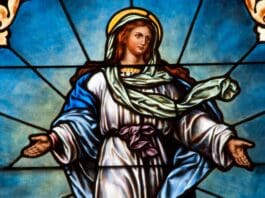
For centuries, the Feast of the Assumption of the Blessed Virgin Mary on August 15 has been a cornerstone of Catholic tradition.
It marks the day Mary was believed to have been taken bodily into Heaven after her earthly demise. However, this widely accepted belief was only formally declared a dogma – an essential teaching of the Catholic Church – in 1950.
The Assumption is intertwined with the Feast of the Immaculate Conception on December 8th. Both are primary feasts dedicated to the Blessed Virgin and are Holy Days of Obligation, making them among the most significant feasts in the Catholic calendar.
While the concept of Mary’s assumption dates back to narratives from the fifth and sixth centuries, it’s worth noting that there is no direct reference to this event in the Bible. Saint Gregory of Tours, in 594, was the first Church writer to touch upon this topic, followed by Ps.-Modestus of Jerusalem around 700 AD.
In a historic moment, Pope Pius XII, in 1946, inquired with bishops worldwide about formalizing this belief. With an overwhelming positive response, he declared on November 1, 1950, the Feast of All Saints, that Mary’s assumption was a divinely revealed dogma.
Details surrounding the exact date, year, and circumstances of Mary’s departure remain shrouded in mystery. Various sources claim her passing occurred between three to fifteen years after Christ’s Ascension. Her final resting place is contested between Jerusalem and Ephesus, the latter believed to be her home post-Jesus’s death. One pious tradition asserts that while her tomb in Jerusalem was initially discovered, it was subsequently found empty. This lead the Apostles to conclude that her body was assumed into heaven.
Saint Gregory of Tours provides insight into this tradition, likening Mary’s sin-free body to the Ark of the Covenant, believed to be crafted from undecaying wood. Thus, he posited it was unthinkable for her body to perish in the grave. This belief is further supported by the text, ‘Rise thou and the ark of thy strength’ (Ps 132/1:8), suggesting that just as Christ ascended, Mary too was destined for heaven.
However, it’s crucial to distinguish between Christ’s ascension and Mary’s assumption. While the former indicates a rise through one’s own power, the latter signifies an external intervention. Jesus, being divine, ascended without aid, whereas Mary, a mortal, was assumed.
Tradition paints a poetic picture of Mary’s end. It’s believed that Saint Michael the Archangel, known to escort souls to heaven, foretold her passing. Miraculously, all the apostles were transported to her side, and upon her death, Jesus is said to have taken her soul. Three days post-burial, her body is believed to have been transported to Paradise by angels, where it reunited with her soul.
Editorial credit: Nancy Bauer / Shutterstock.com
The post The Solemnity Of The Assumption appeared first on uCatholic.
Daily Reading
Solemnity of the Blessed Virgin Mary, the Mother of God
Reading I Numbers 6:22-27 The LORD said to Moses: “Speak to Aaron and his sons and tell them: This is how you shall bless the Israelites. Say to…
Daily Meditation
Mary Kept All These Things in Her HeartMaría guardaba todas estas cosas en su corazón
Click here for daily readings Mary and Joseph have not been asked to walk an easy path. They have had to wrestle with the unknown, travel to a distant land,…




